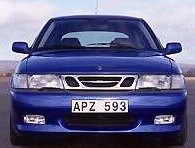9-3
Viggen
 The
name "Viggen" revives my memory as a military enthusiast years ago. I
remember
Saab made several supersonic jet fighters called Viggen, the AJ35, AJ37
and JAS39, they were famous of being capable to launch and land on
Swedish
highway. Today the same company's car division made the 9-3 Viggen. For
your information, "Viggen" means "lightning". The
name "Viggen" revives my memory as a military enthusiast years ago. I
remember
Saab made several supersonic jet fighters called Viggen, the AJ35, AJ37
and JAS39, they were famous of being capable to launch and land on
Swedish
highway. Today the same company's car division made the 9-3 Viggen. For
your information, "Viggen" means "lightning".
This performance
9-3 is more
the work of racing ace TWR than Saab's SVO special vehicle operation.
Tom
Walkinshaw used to make Aston Martin DB7, Jaguar XJ220 and currently
Volvo
C70, so it is not a great challenge for him to modify another Swedish
car.
He fitted a full set of body kits including a rear spoiler, deeper air
dam and side skirts to produce an aerodynamic drag of 0.31 while
reducing
lift by more than 50% over the standard 9-3. Then stiffened the springs
by 30% and installed new dampers, 17-in 215 width rubbers. Brake discs
uprated to 308mm front and 286mm rear.
Otherwise are
left to SVO.
On the 9 years old birthday of the 2.3 litres turbocharged four-pot,
they
gave it a boost in power and torque - now 225hp and 253lbft, compare
with
the standard but discontinued 200hp and 243lbft back to a couple of
years
ago. There are more interesting figures for your reference : today's
2.3
light turbo develops 170hp under the bonnet of 9-5, the 2.0-litre high
boost turbo generates 185hp for the 9-3, but back to 1991 the Saab 9000
Carlsson has the 2.3 unit boosted to 220hp. You can see how tuneable
Saab�s
turbocharged engines are.
Progress of
technology through
the years gives the current 225hp far better manner than 9000
Carlsson's
220hp. The twin-balancer shafts are still there, but electronic
throttle
and Trionic T7 engine management system are purely state-of-the-art. In
addition to the intercooler, they reduce turbo lag to hardly
noticeable.
Those who have driven the 9-3 turbo SE or Volvo S70T5 couldn't
understand
how a near 100hp/litre engine managed to kill turbo lag. The same
question
may be raised to its silky smooth operation.
"Viggen" is
really a suitable
name. As low as 1500rpm the engine works eagerly, at 2000rpm the torque
surges as the turbo is running on full boost. Torque curve flat out
over
a wide rev band between 2500 and 4000rpm, obviously due to the
artificial
work of engine management system. There is so much punch to the extent
that the front wheels spin. Not just on wet, they spin also on dry.
Oddly,
traction control is not even optional equipment to this powerful
front-wheel-drive
sedan.
Apart from wheel
spin, there
is severe torque steer, so severe that devoid of any driving
excitement.
The extraordinary torque only adds the problem to the driver, who is
fighting
hard with the steering wheel and understeer. Don't blame TWR, it can't
do much to alter the inherent flaw of the MacPherson strut front
suspensions.
Last time Alfa experienced torque steer in 164 (also with struts in
front),
they decided to install a double-wishbones setup to the front end of
156.
Of course Saab won't do the same thing to just a derivative of 9-3.
Keep the 9-3
Viggen in straight
line, it will cover the first 60mph in 6.5sec and top 155mph. Fastest
ever
for Saab, but not enough to compensate its flaw in handling.
|
 As
a relatively small mass-production manufacturer with annual production
less than 100,000 units, Saab found itself hard to survive in the
highly
competitive European market. Especially when the increasing competition
from Audi, BMW and Mercedes put great pressure on the Swedish company,
it has to find ways to reduce cost while preserve quality. Under the
control
of its parent company, General Motor, Saab finally started to sacrifice
its independence of R&D and base its model on those developed by
the
European arm of GM ( GME, which consists of Germany's Opel and
Britain's
Vauxhall ).
As
a relatively small mass-production manufacturer with annual production
less than 100,000 units, Saab found itself hard to survive in the
highly
competitive European market. Especially when the increasing competition
from Audi, BMW and Mercedes put great pressure on the Swedish company,
it has to find ways to reduce cost while preserve quality. Under the
control
of its parent company, General Motor, Saab finally started to sacrifice
its independence of R&D and base its model on those developed by
the
European arm of GM ( GME, which consists of Germany's Opel and
Britain's
Vauxhall ).
 The
name "Viggen" revives my memory as a military enthusiast years ago. I
remember
Saab made several supersonic jet fighters called Viggen, the AJ35, AJ37
and JAS39, they were famous of being capable to launch and land on
Swedish
highway. Today the same company's car division made the 9-3 Viggen. For
your information, "Viggen" means "lightning".
The
name "Viggen" revives my memory as a military enthusiast years ago. I
remember
Saab made several supersonic jet fighters called Viggen, the AJ35, AJ37
and JAS39, they were famous of being capable to launch and land on
Swedish
highway. Today the same company's car division made the 9-3 Viggen. For
your information, "Viggen" means "lightning".